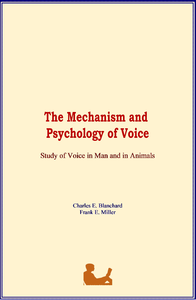The Mechanism and Psychology of Voice — Ebook
Study of Voice in Man and in Animals
| Auteurs : | Charles E. Blanchard, Frank E. Miller |
| Publication : | 14/10/2019 |
| Langue : | English |
| Éditeur : | Literature and Knowledge Publishing |
| ISBN : | 9782366598209 |
| Catégories : | Psychologie / Psychologie physiologique, Science / Sciences de la vie / Anatomie et physiologie |
Man possesses language, and makes large use of it, while, on the other hand, not even the most intelligent animals have the power of designating objects, or of translating sensations into articulate speech. In this respect the distinction between man and beast is very marked. It has at all times been cited as an evidence of man's exceptional place in Nature. The physiologist, however, discovers an articulate voice in many animals. Some mammals give utterance to vowels and consonants, but the result is only one syllable repeated without variation. Birds, better gifted than the mammals, can sing, and also possess a brief vocabulary: the goldfinch pronounces several words, which it repeats again and again in moments of pleasure. It has a word to express its ill-humor, as also a word for calling attention. In all this we see faint traces of language, notable witnesses of the unity of a phenomenon the gradations of which are wanting ...
Sound has three dimensions: pitch, loudness and timbre.
Pitch depends upon the frequency of vibrations. The more rapid the vibrations, the higher the pitch.
Loudness is determined by the amplitude of the vibrations. As their length or "excursion" increases, so does the sound gain in loudness. Conversely, the diminution in the size of vibrations causes corresponding decrease of loudness.
Differences in the shapes of vibrations cause differences in quality or timbre.
After voice has originated within the restricted limits of the larynx, its power, its carrying quality is much augmented by the sympathetic vibrations within the resonance cavities above the larynx. These include the pharynx, nasal passages, mouth, bone cavities of the face—in fact pretty much every hollow space in the head, every space that will resound in response to vibration and assist in multiplying it. Moreover, the cavities of resonance by their differences in shape in different individuals determine the timbre or quality of individual voices. The chest, although situated below the larynx, is a resonance cavity of voice. In fact, in a certain register its vibration is felt so distinctly that we speak of these notes as being sung in the "chest register," which, so far as it implies that the tones are produced in the chest, is a misnomer. The same is true of "head register," in which vibration is felt in the head where, however, it is needless to say, the "head tones" do not originate.
Détails du livre numérique
| Format de fichier | Protection | Services 7switch |
|---|---|---|
| ePub | Tatouage | Aucun |
| Mobipocket | Tatouage | Send-to-Kindle |
| Version Web | Aucun |
